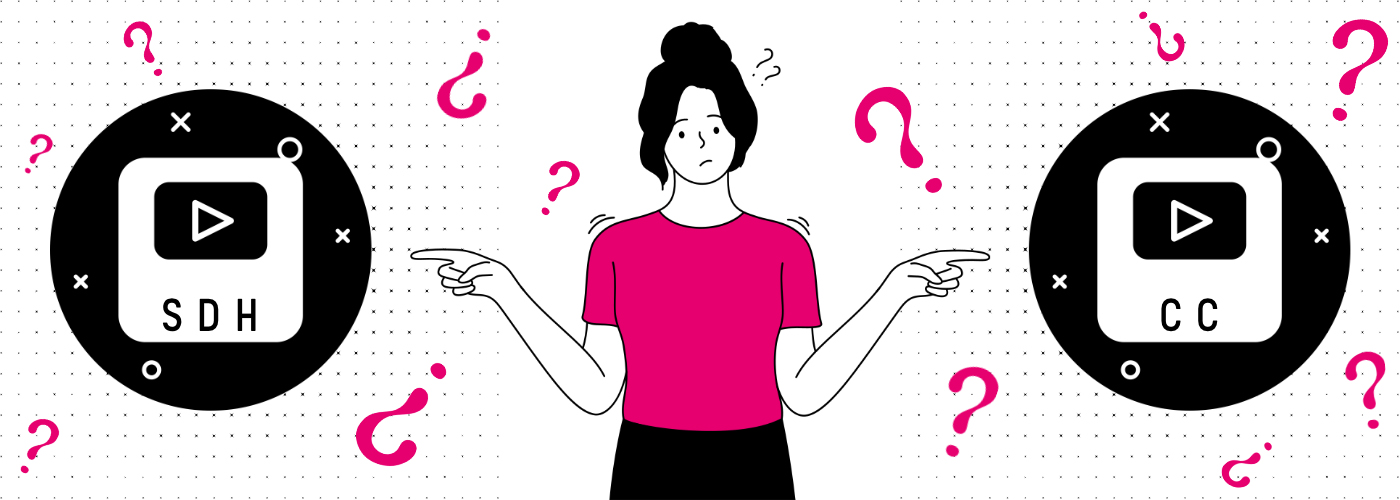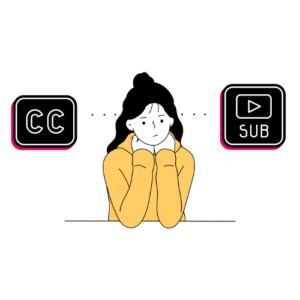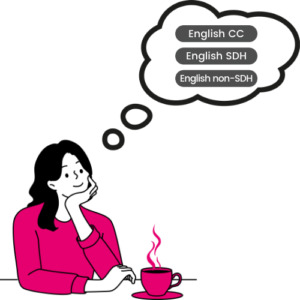SDH vs. CC: What’s the Difference?
Updated: December 13, 2023
The Ultimate Guide to Subtitles: Different Types, How They Work, and When to Use Them [Free Ebook]
When it comes to media accessibility, one of the most common questions from television viewers revolves around the differences between subtitles and closed captions. But between the rise of streaming content and the global use of the term “subtitles” versus “captions,” the answer has become complicated.
As the lines between subtitles and captions continue to blur, perhaps none has become more confusing than the difference between subtitles for the d/Deaf and hard of hearing (SDH) and closed captions (CC).
The issue of SDH vs. CC has been compounded by the availability of both options on certain streaming platforms. Adding further confusion, there’s also the matters of:
- Mixed usage of terminology
- Different interpretations of what makes a timed text file SDH or CC
- General misinformation on the purpose and function of SDH vs. CC files
This widespread confusion is precisely why we’ve decided to tackle SDH vs. CC in this blog. We’ll review the key differences between subtitles and closed captions, closely examine SDH subtitles, cover each of their respective roles and use cases, and explain why some streaming services are moving towards offering both options to viewers.
Looking for a described version of this video? We’ve got you covered!
Defining Subtitles and Captions
Before fully understanding the difference between SDH and closed captions, it is helpful to first understand the basic differences between subtitles and captions.
How are they alike?
Both subtitles and captions are timed text files synchronized to media content, allowing the text to be viewed at the same time the words are being spoken. Captions and subtitles can be open or closed.
How are they different?
In the United States and Canada, subtitles are intended for hearing viewers who do not understand the language. Traditionally, subtitles show the spoken content but not the sound effects or other audio elements. They are often used to refer to translations (think: subtitles for a foreign film.) In places like the UK, the term “subtitles” is used to describe both subtitles and captions.
Closed captions are designed for d/Deaf and hard-of-hearing audiences. They communicate all audio information, including sound effects, speaker IDs, and non-speech elements. They originated in the 1970s and are required by law for most video programming in the United States and Canada.
What are Subtitles for the d/Deaf and Hard of Hearing (SDH)?
It’s important to note that there are a few different types of subtitles. The most frequently used types are known as: SDH, non-SDH, and forced narrative (FN).
SDH stands for subtitles for the d/Deaf and hard of hearing. These subtitles assume the end user cannot hear the dialogue and include important non-dialogue information such as sound effects, music, and speaker identification. In the United States and Canada, SDH traditionally assumes the end user cannot understand the language being spoken, whereas traditional subtitles (also referred to as non-SDH) assume the viewer can hear the audio but doesn’t know the spoken language.
SDH often emulates closed captions on media that does not support closed captions, such as digital connections like HDMI or OTT platforms. In recent years, many streaming platforms, like Netflix, have been unable to support standard broadcast Line 21 closed captions. This has led to a demand for English SDH subtitles styled similarly to FCC-compliant closed captions instead.
SDH can also be translated into foreign languages to make content accessible to d/Deaf and hard-of-hearing audiences who speak other languages.
Yes! It’s common in the United States and Canada to find closed caption offerings in Spanish and French, along with other languages. The FCC even requires Spanish CC for all Spanish television programming in the US. There are limitations with translated closed captions, however. Because of CC’s line limits and lack of extensive international character support outside of Western languages, SDH subtitles are preferred to get the most accurate translations for d/Deaf and hard of hearing viewers across languages.
3Play Media Explains… SDH vs. CC – Watch the Video 👀
A Deep Dive into SDH vs. CC
SDH subtitles and closed captions are closely related, and there’s often confusion between the two. One of the main reasons? Preferred jargon.
The term “closed captions” has dominated the vernacular for nearly half a century in North America. The term “subtitles” has encapsulated any timed text format in the UK and other parts of the globe.
But in recent years, rapid developments in streaming content and the globalization of media has shaken up the popular nomenclature across the world. This has left viewers and users of these accessibility services scratching their heads and wondering how SDH and CC are different.
Appearance

SDH subtitles styled to closely resemble closed captions: white text with a semi-transparent black background.
SDH subtitles have a lot of flexibility in terms of appearance. They can be customized by professional captioners to look exactly like closed captions, or styled to match a customer’s request or platform’s specifications.

SDH subtitles styled to a standard subtitling appearance: white text, black outline, no background.
SDH subtitles’ appearance can sometimes be determined by a video player or platform, which sets the appearance independently of the original captioner. Occasionally, SDH can also be customized by the end user, but this varies based on the player or platform’s customization options.

Default closed captioning style: white text on an opaque black background.
By default, closed captions are displayed as white text on a black box, with placement that is customized on the captioner’s end. This has changed over the years with the introduction of digital television and 708 captioning standards, which allows for user customization.
Placement
SDH subtitles and closed captions are both capable of supporting placement. Viewers often find SDH and CC are placed in the bottom center, with movement to the top to avoid lower thirds. Some styles of CC may include horizontal placement to indicate speaker changes.
SDH can theoretically be placed anywhere on the screen if they are burned-in. As a best practice, SDH are typically centered for readability and ease in the translation process.
Caption placement is usually implemented by a captioner and cannot be adjusted by the user unless the captions are formatted to 708 standards. According to FCC rules, captions must be positioned in such a way to avoid covering important lower third graphics.
Ultimately, SDH and CC positioning is dictated by the file type being used, or by the requested formatting specs from a platform or television network.
Streaming services that follow this trend include Netflix and Amazon.
Encoding
The move from analog television to high-definition (HD) media over the last 20 years had major implications for the encoding of closed captions and subtitles.
Standard 608 closed captions are transmitted via Line 21 as a stream of commands, control codes, and text. 708 closed captions are transmitted via MPEG-2 video streams in MPEG user data.
Subtitles, on the other hand, are often encoded as bitmap images – a series of tiny dots or pixels. And this method of transmission is a lot more compatible with newer digital media methods.
HD disc media, like Blu-ray, does not support traditional closed captioning but is compatible with SDH subtitles. The same goes for some streaming services and OTT platforms. SDH formats are increasingly used on these platforms due to their inability to support traditional Line 21 broadcast closed captions. That being said, some classic captioning formats, like SCC, have proven to be versatile across television and digital formats.
SDH vs. CC: At a Glance
| Features | SDH | Closed Captions |
| Timed text synced to video | ✓ | ✓ |
| Can be turned on/off | ✓ | ✓ |
| In source language | ✓ | ✓ |
| Speaker Identification | ✓ | ✓ |
| Sound effects | ✓ | ✓ |
| Translation options | ✓ | Limited |
| Text appearance | Varies; often white text on black or semi-transparent background to mimic captions | Usually white text on black background |
| On-screen placement | Varies; typically centered at the bottom, with movement to the top for lower third graphics | Varies |
| Encoding | Supported through HDMI | Not supported through HDMI |
Why Do Streaming Platforms Sometimes Include Both SDH and CC?
While many streaming and OTT platforms only offer one timed text option for viewers to use, some have started offering both SDH and CC options when available.
Apple TV+ is one of such platforms offering a wide array of accessibility choices for viewers on select programming. Depending on the program chosen, a viewer could find themselves choosing between CC and SDH. So why offer this?
The answer can be different depending on the platform, but by offering both options, viewers are able to choose the format that they prefer. In situations where there is no distinction made between CC and SDH, the file could be considered one in the same.
When both options are available to select, it’s often likely that the captions originate from a true CC file and are formatted to match that style; whereas the SDH could be a simpler timed transcript in the source language that was intentionally designed for translation into other languages. The difference between the two isn’t always clear when both are offered on a platform, but usually comes down to how each is displayed.
Closed captions and subtitles for the d/Deaf and hard of hearing are like siblings: closely related, with similar mannerisms, yet each has their own unique traits and appearance.
Like many media accessibility services, CC and SDH are nuanced and tricky to definitively declare as being one specific solution designed for one specific purpose. In the greater scheme of timed text files, either solution offered by a television network or streaming platform will provide an accessible experience for viewers.
Neither CC or SDH will ever fit neatly into one box, and it’s possible that defining them may only get more complicated as digital video evolves. But one thing remains certain for CC and SDH: they will always serve the d/Deaf and hard of hearing community first and foremost.
This blog was originally published by Lily Bond on May 21, 2014 as “How Subtitles for the Deaf and Hard-of-Hearing (SDH) Differ From Closed Captions.” This blog was updated on August 24, 2021 by Elisa Lewis and has since been updated again for comprehensiveness, clarity, and accuracy.








